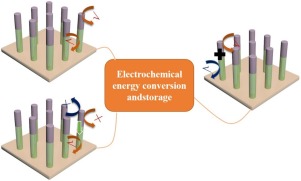当前位置:
X-MOL 学术
›
Nano Today
›
论文详情
Our official English website, www.x-mol.net, welcomes your
feedback! (Note: you will need to create a separate account there.)
Heterogeneous nanostructure array for electrochemical energy conversion and storage
Nano Today ( IF 13.2 ) Pub Date : 2018-06-01 , DOI: 10.1016/j.nantod.2018.04.002 Min Zhou , Yang Xu , Yong Lei
Nano Today ( IF 13.2 ) Pub Date : 2018-06-01 , DOI: 10.1016/j.nantod.2018.04.002 Min Zhou , Yang Xu , Yong Lei

|
Abstract Rapid development of modern society raises more and more requirements for highly efficient energy conversion and storage. Electrochemical devices stand out as a most viable option for eventual substitute for fossil fuels, but suffer from problems like durability, operability, etc. Heterogeneous nanostructure arrays with distinguished superiorities have thus attracted intensive attention and yielded favorable electrochemical performance. In pursuit of deep understandings of their working modes, this review will focus on the interconnection among different constituents within each individual unit to correlate microscopic electrochemical processes with macroscopic performance. Here, the motivation of employing heterogeneous nanostructure arrays is first summarized. Then, the design principles, including three working modes, ‘Function-Function’, ‘Function-Assistance’, ‘Single-unit device’, are analyzed comprehensively to illuminate the interconnection among different constituents in electrochemical energy conversion and storage processes. Solar water splitting (energy conversion), alkali-ion battery and supercapacitors (energy storage) are termed collectively as typical electrochemical energy technologies to illustrate the superiorities of heterogeneous nanostructure arrays. Finally, perspectives of related fields will be concluded to broaden the future of heterogeneous nanostructure arrays.
中文翻译:

用于电化学能量转换和存储的异质纳米结构阵列
摘要 现代社会的快速发展对高效的能量转换和存储提出了越来越多的要求。电化学装置作为最终替代化石燃料的最可行选择脱颖而出,但存在耐用性、可操作性等问题。具有显着优势的异质纳米结构阵列因此引起了广泛关注并产生了良好的电化学性能。为了深入了解它们的工作模式,本综述将重点关注每个单元内不同成分之间的互连,以将微观电化学过程与宏观性能相关联。在这里,首先总结了采用异质纳米结构阵列的动机。然后,设计原则,包括三种工作模式,综合分析“功能-功能”、“功能-辅助”、“单单元装置”,阐明电化学能量转换和存储过程中不同成分之间的相互联系。太阳能水分解(能量转换)、碱离子电池和超级电容器(储能)统称为典型的电化学能源技术,以说明异质纳米结构阵列的优越性。最后,将总结相关领域的观点,以拓宽异质纳米结构阵列的未来。碱离子电池和超级电容器(储能)统称为典型的电化学能源技术,以说明异质纳米结构阵列的优越性。最后,将总结相关领域的观点,以拓宽异质纳米结构阵列的未来。碱离子电池和超级电容器(储能)统称为典型的电化学能源技术,以说明异质纳米结构阵列的优越性。最后,将总结相关领域的观点,以拓宽异质纳米结构阵列的未来。
更新日期:2018-06-01
中文翻译:

用于电化学能量转换和存储的异质纳米结构阵列
摘要 现代社会的快速发展对高效的能量转换和存储提出了越来越多的要求。电化学装置作为最终替代化石燃料的最可行选择脱颖而出,但存在耐用性、可操作性等问题。具有显着优势的异质纳米结构阵列因此引起了广泛关注并产生了良好的电化学性能。为了深入了解它们的工作模式,本综述将重点关注每个单元内不同成分之间的互连,以将微观电化学过程与宏观性能相关联。在这里,首先总结了采用异质纳米结构阵列的动机。然后,设计原则,包括三种工作模式,综合分析“功能-功能”、“功能-辅助”、“单单元装置”,阐明电化学能量转换和存储过程中不同成分之间的相互联系。太阳能水分解(能量转换)、碱离子电池和超级电容器(储能)统称为典型的电化学能源技术,以说明异质纳米结构阵列的优越性。最后,将总结相关领域的观点,以拓宽异质纳米结构阵列的未来。碱离子电池和超级电容器(储能)统称为典型的电化学能源技术,以说明异质纳米结构阵列的优越性。最后,将总结相关领域的观点,以拓宽异质纳米结构阵列的未来。碱离子电池和超级电容器(储能)统称为典型的电化学能源技术,以说明异质纳米结构阵列的优越性。最后,将总结相关领域的观点,以拓宽异质纳米结构阵列的未来。











































 京公网安备 11010802027423号
京公网安备 11010802027423号